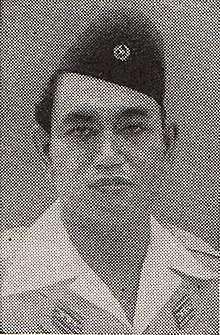Maludin Simbolon
| Maludin Simbolon | |
|---|---|
 | |
| Nationality |
|
| Occupation | Military |
| Known for | Indonesian independence fighter, Revolutionary Government of the Republic of Indonesia |
| Spouse(s) | Paniyem |
| Children | 5 |
| Parent(s) | J. Simbolon, N. Lumbantobing |
Colonel Maludin Simbolon (1916 - 2000) was an Indonesian military figure, independence fighter, and Minister of Foreign Affairs in the Revolutionary Government of the Republic of Indonesia's (PRRI) Cabinet.[1]
Background
Maludin Simbolon was the second of ten children of his parents, Julius Simbolon and Nursiah Lumbantobing.[2] His father worked as a plantation foreman in Pearaja, Tarutung, North Tapanuli Regency.[2]
Simbolon took his basic education at HIS Siantar Narumonda, then continued at Chr. HIK (teacher school) Solo, Central Java, and graduated in 1938.[2] He met his future wife Paniyem in Solo,[3] and from their marriage they had five children.[2]
Before the outbreak of World War II, he had taught as a teacher at HIS Solo, and also in Curup, Bengkulu.[2][4]
Military career
Simbolon entered Gyugun's (義勇軍 giyûgun, voluntary army) training during the Japanese Occupation, and afterward graduated as a Second Lieutenant.[2] He was later assigned to the Gyugun battalion headquarters in South Sumatra, in the education and training section.[2]
Immediately after the Proclamation of Indonesian Independence, the People's Security Army (TKR) was formed and he was appointed Commander of the Palembang Ulu Division, with the rank of Colonel.[2] In a reorganization of TKR forces in Sumatra, Simbolon was appointed Commander of Division I / Lahat (1945-46), who supervised 4 regiments and 15 battalions in South Sumatra.[2][4] When TKR was changed into the Republic of Indonesia's Army (TRI), Simbolon became Commander of the Garuda VII Division in South Sumatra, which oversaw Lampung, Bengkulu, Palembang, and Jambi.[2]
During the Second Dutch Military Aggression, the Emergency Government of the Republic of Indonesia was formed in Sumatra, in which A.K. Gani became military governor and Maludin Simbolon became the deputy.[2][4] In 1950, he was appointed commander of the Bukit Barisan Territorial-I Army Command, which was formed in conjunction with the formation of the North Sumatra Province which included Aceh, North Tapanuli, South Tapanuli, West Sumatra, and East Sumatra.[2]
PRRI involvement
Maludin Simbolon was among the regional leaders in Sumatra and Sulawesi, who were dissatisfied with various central government policies in the late 1950s.[1][5] Some of the demands desired by the regional leaders were improvement of soldier welfare, greater regional autonomy, and replacement of some of the civil and military officials in Jakarta.[1][5]
Simbolon later joined the Revolutionary Government of the Republic of Indonesia (PRRI), and announced the termination of the North Sumatra military region's relationship with the central government on December 22, 1956 in Medan, although remained loyal to leadership of the duumvirate Soekarno-Hatta.[5] The Ali Sastroamidjojo Cabinet in Jakarta that night also held an emergency meeting, and in the morning President Soekarno announced Simbolon's removal from his position and appointed his deputy, Lieutenant Colonel Djamin Gintings, to secure the situation.[1][5] Also mentioned that Lt. Col. Abdul Wahab Makmoer was to be the next commander, should Lt. Col. Gintings failed the effort.[1][5]
Fast movements of troops led by Lt. Col. Gintings were immediately abled to control important positions in Medan.[1][5] Jakarta then sent paratroopers deployed in Medan to support Gintings' forces, so the troops loyal to Simbolon backed away from fighting to the north of Medan, then to Balige, Central Tapanuli.[5] Simbolon and the troops loyal to him then continued the guerrilla resistance and coordinated with other PRRI forces under Lt. Col. Achmad Husein in Bukittinggi.[1][6] Besides Medan, the central government also deployed paratroopers and landed troops from the sea in Palembang and Padang, to effectively control the PRRI resistance cities in Sumatra.[7]
On July 27, 1961, Maludin Simbolon with his staff and the troops of "Pusukbuhit Division" surrendered formally to the Commander of Kodam II, Lt. Col. Manaf Lubis in Balige, thus ending their resistance to the central government.[8]
Death
Maludin Simbolon passed in 2000, aged 84 years old.[9]
See also
References
- 1 2 3 4 5 6 7 Kahin, Audrey; Kahin, George McTurnan (1997). Subversion as Foreign Policy: The Secret Eisenhower and Dulles Debacle in Indonesia. University of Washington Press. ISBN 9780295976181.
- 1 2 3 4 5 6 7 8 9 10 11 12 Damanik, Erond L. (2010-01-28). "Kolonel Maludin Simbolon: Ingatan Kolektif Masyarakat Terhadap Jatuhnya Pesawat Tentara Pusat di Huta Tongah". Pusat Studi Sejarah dan Ilmu-ilmu Sosial Lembaga Penelitian-Universitas Negeri Medan (Pussis Unimed)'s Blog. Retrieved 2017-10-16.
- ↑ Pearaja TV (15 June 2011). "Kolonel Inf Maludin Simbolon". pearajatv.blogspot.com. Retrieved 7 August 2018.
- 1 2 3 Simatupang, T. B. (2009). Report from Banaran: Experiences During the People's War. Equinox Publishing. ISBN 9786028397551.
- 1 2 3 4 5 6 7 Stoler, Ann Laura (1995). Capitalism and Confrontation in Sumatra's Plantation Belt, 1870-1979. University of Michigan Press. ISBN 0472082191.
- ↑ Dixon, Jeffrey; Sarkees, Meredith Reid (2015-08-15). A Guide to Intra-state Wars. SAGE. ISBN 9780872897755.
- ↑ Conboy, Kenneth J. (2003). Kopassus: Inside Indonesia's Special Forces. Equinox Publishing. ISBN 9789799589880.
- ↑ Anwar, Rosihan (2006). Sukarno, tentara, PKI: segitiga kekuasaan sebelum prahara politik, 1961-1965 (in Indonesian). Yayasan Obor Indonesia. ISBN 9789794616130.
- ↑ Tempo (in Indonesian). Badan Usaha Jaya Press Jajasan Jaya Raya. 2007. p. 49.